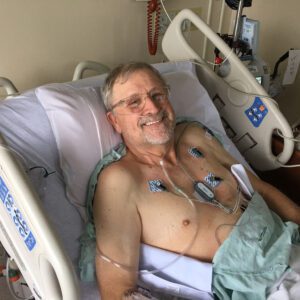Carol, our Vice President of Operations for Home Health and Home Nursing, recently saved her brother Neal’s life. She was determined to expose the cause behind the problems her hospitalized brother was experiencing, as he deteriorated in front of her own eyes. She refused to allow the “healthcare establishment” to continue their practice of simply treating symptoms while the underlying cause continued to brew.
Where it all began
A few weeks ago, Neal underwent surgery for a routine hernia repair during which a large sheet of mesh was placed.
Post surgery, the mesh became infected, and, after being home for two weeks, Neal was rushed into emergency surgery. The mesh was removed; and his abdomen was inspected and treated with massive antibiotics in an effort to prevent sepsis. He had a drain on one side, a wound vac on the other, and a gaping wound with packing. But, he was on his way to a full recovery. He simply needed good nutrition and rest. The “healthcare establishment” said he would heal quickly and ultimately be fine.
What? SpO2 begins to tank
After Neal’s second surgery, his SpO2 level began to tank. The hospital simply treated the symptom by administering supplemental oxygen.
Although his oxygen requirement was continuous, it was almost Thanksgiving and the hospital was sending him home without supplemental oxygen. But why would they send him home without supplemental oxygen when he required it in the hospital? Was his need for supplemental oxygen going to miraculously subside when he returned home? How would he be able to heal without the necessary oxygen in blood supply to all of his organ systems? After multiple requests and denials, the surgeon finally agreed to send Neal home with supplemental oxygen.
However, on Thanksgiving Day, his SpO2 continued to decline and his requirement for supplemental oxygen continued to rise. He struggled to breathe; and with minimal exertion, his SpO2 never exceeded 91% while on five liters of oxygen.
Why?
The hospital proceeded with their plan to discharge him home. No one suggested running the necessary tests to determine the cause for increasing oxygen need and his declining ability to breathe.
Carol knew in her gut that this plan would result in disaster. She knew that the underlying cause needed to be identified and accurately treated; but, this was an excellent hospital and the hospital staff had been kind and thoughtful.
What to do?
After a thorough discussion with a colleague, Carol requested that an ABG (Arterial Blood Gas) be drawn so that they could better understand what was transpiring with Neal’s overall condition. Was it just going to show a low PaO2? Then would they be willing to perform a CT of his chest? Or was his PaCO2 abnormal as well? And what about his pH and HCO3? What was going on and why wasn’t the “healthcare establishment” concerned enough to investigate further?
After two requests for an ABG, and two denials, Carol called the surgeon directly and asked for a personal favor: “Please order an ABG for my brother,” Carol asked. The surgeon reluctantly agreed, not because Neal required the test, but, because Carol was demanding.
ABG resulted in a PaO2 of 58; his PaCO2 was normal and his pH was high normal.
Wow, well, the PaO2 of 58 “woke them up.” He was sent for a CT of his chest.
Results
Chest CT exposed bi-lateral pulmonary emboli.
Yes, the emboli are resolving in his chest with the proper treatment. The disaster was diverted, and Carol’s insistence literally saved Neal’s life by identifying and treating the cause prior to the emboli traveling to his heart or brain, which, could have been a fatal result.
Neal would weather this storm with the proper treatment.
Carol is a believer in IPI’s approach to patients, which, does not necessarily adhere to the existing “healthcare establishment”:
- Learn and utilize the science, always, every time.
- Recognize abnormalities and demand explanations.
- Listen to family members. If they think something is wrong, something is probably brewing. Listen to them and report findings.
- Elevate issues. As a healthcare professional, if the physician says “no” to your request and you believe this is a mistake, elevate the issue immediately.
- Listen to your gut. If it’s not really important, let it go; but never give up advocating for something that could be life-saving!
- Do whatever it takes to prevent preventable complications.

